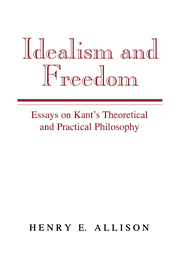Book contents
- Frontmatter
- Contents
- Acknowledgments
- Note on sources and key to abbreviations and translations
- Introduction
- Part I Kant's theoretical philosophy
- 1 Transcendental idealism: A Retrospective
- 2 Reflections on the B-Deduction
- 3 Apperception and analyticity in the B-Deduction
- 4 On naturalizing Kant's transcendental psychology
- 5 Gurwitsch's interpretation of Kant: Reflections of a former student
- 6 Causality and causal law in Kant: A critique of Michael Friedman
- 7 Kant's refutation of materialism
- Part II Kant's practical philosophy
- Notes
- Index
1 - Transcendental idealism: A Retrospective
Published online by Cambridge University Press: 05 June 2012
- Frontmatter
- Contents
- Acknowledgments
- Note on sources and key to abbreviations and translations
- Introduction
- Part I Kant's theoretical philosophy
- 1 Transcendental idealism: A Retrospective
- 2 Reflections on the B-Deduction
- 3 Apperception and analyticity in the B-Deduction
- 4 On naturalizing Kant's transcendental psychology
- 5 Gurwitsch's interpretation of Kant: Reflections of a former student
- 6 Causality and causal law in Kant: A critique of Michael Friedman
- 7 Kant's refutation of materialism
- Part II Kant's practical philosophy
- Notes
- Index
Summary
From the mid '70s to the early '80s, the period in which I was working on Kant's Transcendental Idealism, the dominant understanding of Kant's idealism, at least in the Anglo-American philosophical world, was what is generally termed the “two-object” or “two-world” view. According to this view, which can be traced back to Kant's immediate contemporaries, the transcendental distinction between appearances and things in themselves is construed as holding between two types of object: appearances or “mere representations,” understood as the contents of particular minds, and things in themselves, understood as a set of transcendentally real but unknowable things, which somehow underlie or “ground” these appearances. Such a dualistic picture is easy to criticize, since it combines a phenomenalism regarding the objects of human cognition with the postulation of a set of extra-mental entities, which, in terms of that very theory, are unknowable. Thus, given the widespread acceptance of this reading of Kant's idealism, it is not difficult to understand the popularity of P. F. Strawson's The Bounds of Sense (1966), in which he taught a generation of analytical philosophers that, by focusing on the “analytic argument” of the Critique, it is possible to have one's Kant, or at least a scaled down version thereof, without the excess baggage of transcendental idealism.
Already in the late '60s, at the very beginning of my serious study of Kant, I was deeply suspicious of the Strawsonian approach, particularly the underlying assumption that one can so easily separate Kant's substantive philosophical claims concerning the conditions of experience from his idealism.
- Type
- Chapter
- Information
- Idealism and FreedomEssays on Kant's Theoretical and Practical Philosophy, pp. 3 - 26Publisher: Cambridge University PressPrint publication year: 1996
- 5
- Cited by



